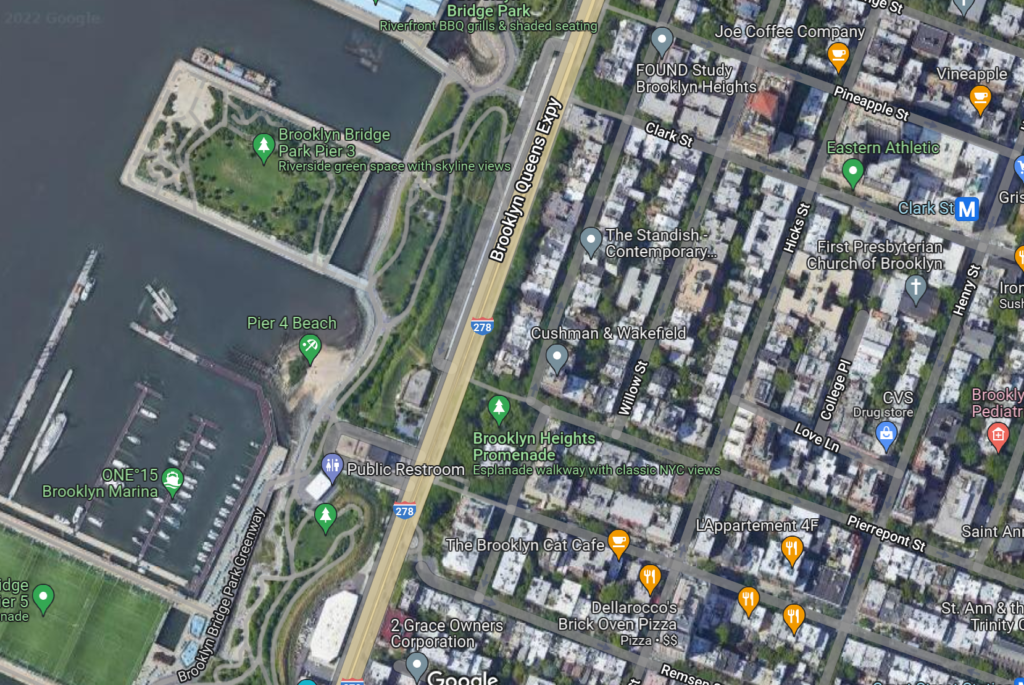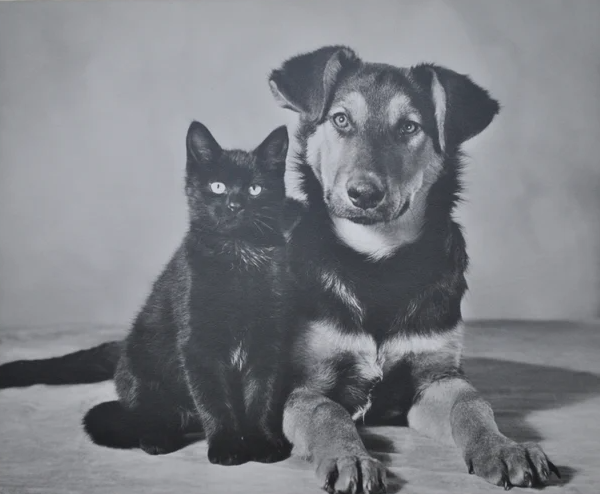
Many old stories have been told of the Brooklyn-born canine and feline mascots that went to sea (like Peggy and Tom of the USS Maine, as an example), but this tale, which takes place at Pier 12 of the New York Dock Company, is about a landlubber dog and cat who patrolled the Brooklyn waterfront.
Brownie, aka Guardian of the Cats and Killer of the Rats, began his duties on the waterfront sometime around 1921. Although he patrolled many of the piers of the New York Dock Company, he was partial to Pier 12, which then served as the wharf for the Royal Netherlands Steamship Co.
(This steamship line, officially called the Koninklijke Nederlandsche Stoomboot Maats (KNSM), was founded in 1856 by a group of Dutch entrepreneurs. In 1888, it began service from Brooklyn to Haiti, Curacao, Venezuela, Trinidad, and the British and Dutch Guianas.)
During his reign, Brownie was said to be the only dog who patrolled along the waterfront. He had many accidents over the years, but apparently Brownie was like a cat in that he had several lives.
According to his owner, pier watchman Joe Santanelli, one time Brownie fell down a ship’s hatch and nearly broke his back. Another time he became wedged between two trucks and had to receive four stiches in his head. He also spent two weeks at the animal hospital after some scalding coffee accidentally spilled on him (he still bore the scars from that incident).
Even when he was an old dog in 1934, Brownie was still frisky, playful, and intelligent. His days consisted of jumping off the pier and bathing in the river, catching rats, sunning himself on the running boards of cars, and waiting in front of the ships’ galleys at high noon for handouts from the cooks who all knew and loved him.
The ship cooks were some of Brownie’s best friends, but he was also friends with more sailors, truckmen, and dock workers than anyone else in Brooklyn. His best friend, though, was Joe Santanelli. Every morning at 4:30, Brownie would sit by Pier 12 near the foot of Montague and Pierrepont Streets waiting for Joe to come to work.

In 1933, Brownie made his first four-legged friend when a cat came walking down Pier 12 to meet Flora, one of the Royal Netherlands steamships. No cat had ever lived at Pier 12 before–probably because Brownie was always on guard–but the cat didn’t seem to mind the canine competition. The dock workers named her Flora.
For one year, Flora the cat never left Pier 12. She even gave birth to a few kittens there, including Blackie and Rosie (their father could have been any one of the six Tom cats that lived at the Red D piers adjacent to Pier 12). Flora, Blackie, and Rosie shared a bed with Brownie, and they all ate from the same food container. The cats and dog were also known as the best rat killers on the Brooklyn waterfront.
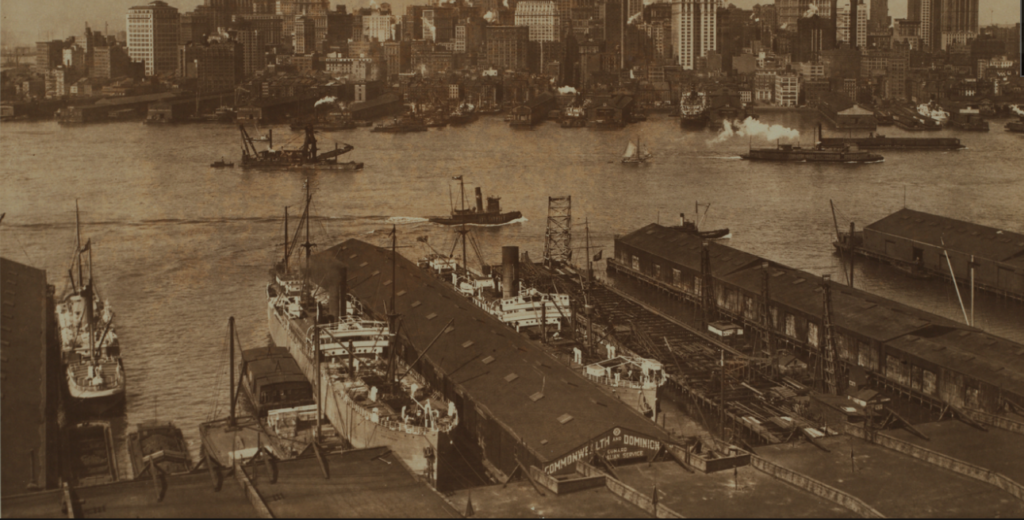

In addition to Blackie and Rosie, who stayed at Pier 12 with their mother, Flora had several other kittens that moved on to other lives. One kitten reportedly moved into a “swanky apartment” on Riverside Drive in Manhattan. Two of her other kittens were lured by the sea and stowed away to the Caribbean aboard the Royal Netherland’s cargo ship Amor (hopefully they got off this ship before it sunk after striking a German mine in 1940).
One day in late October 1934, Flora, who was then pregnant again, stowed away on one of the Royal Netherlands ships. About a week later, poor Blackie and Rosie died of rat poisoning from the bodies of two poisoned rats.
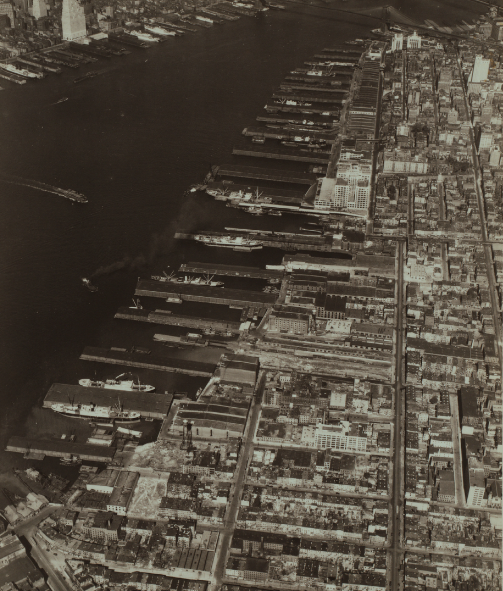
Brownie had adored Flora and her kittens, and according to Joe, he went into mourning after they were all gone. Not only did the cats help Brownie catch rats, Joe said, but they also made his life more interesting.
Joe told a reporter from the Brooklyn Daily Eagle that he and Brownie were actively searching for more cats to take the places of the departed.
With all the cats coming and going on the hundreds of ships at Pier 12 and all along the Brooklyn waterfront, I have a feeling they didn’t have to search for long. (Surely, there were a few landlubber cats that would be willing to share their duties with a kind dog.)
A Brief History of Pier 12 of the New York Dock Company
The New York Dock Company was a rail-marine terminal incorporated in July 1901, when it purchased the Brooklyn Wharf and Warehouse property from under foreclosure. The property of the dock company comprised close to three miles of waterfront, from the Brooklyn Bridge to the Erie Basin. In addition to 39 piers (which served about 19 different steamship lines), the property included more than 200 warehouses and three railroad terminals, as well as land under the water.
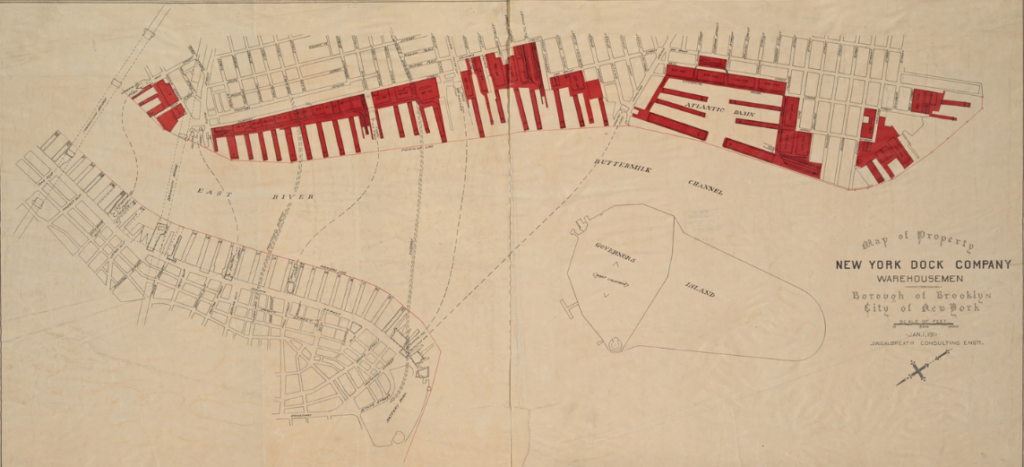
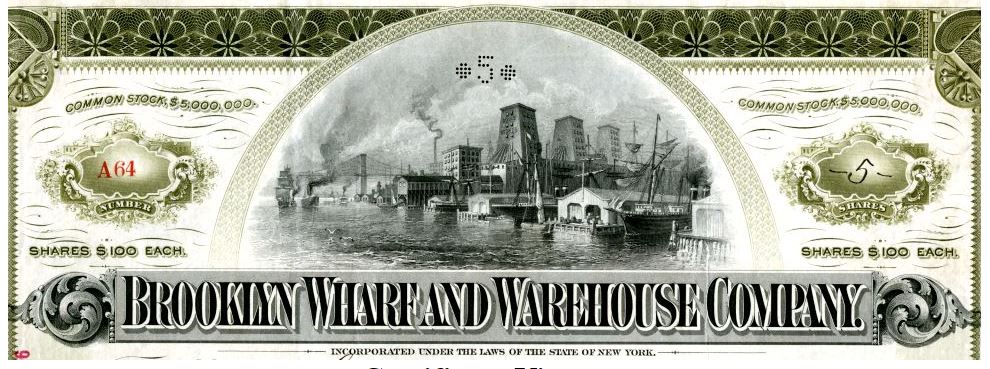
The Brooklyn Wharf and Warehouse Company was founded by a group of old monied men from the Heights, including Messrs. Pierrepont, Woodruff, Clinton, Dow, Robert, and Prentice. In the early 1800s, these men each owned a waterfront strip within walking distance of their homes, with fingertip piers for bathing, fishing, and pleasure boats. In later years, these families established stores, or warehouses, on their property. (During this time, the Heights referred to the bluff, not to the entire neighborhood.)
Hezekiah Beers Pierrepont, for example, kept a small boat at his pier, which he used to row himself to work in New York City every day. He accessed the pier via a set of stone steps along present-day Montague Street, which had once been a cow path and ditch on the old Robert Benson farm. These steps led from the Pierrepont mansion, aka The Four Chimneys, on the hill at today’s Montague Street and Pierrepont Place.
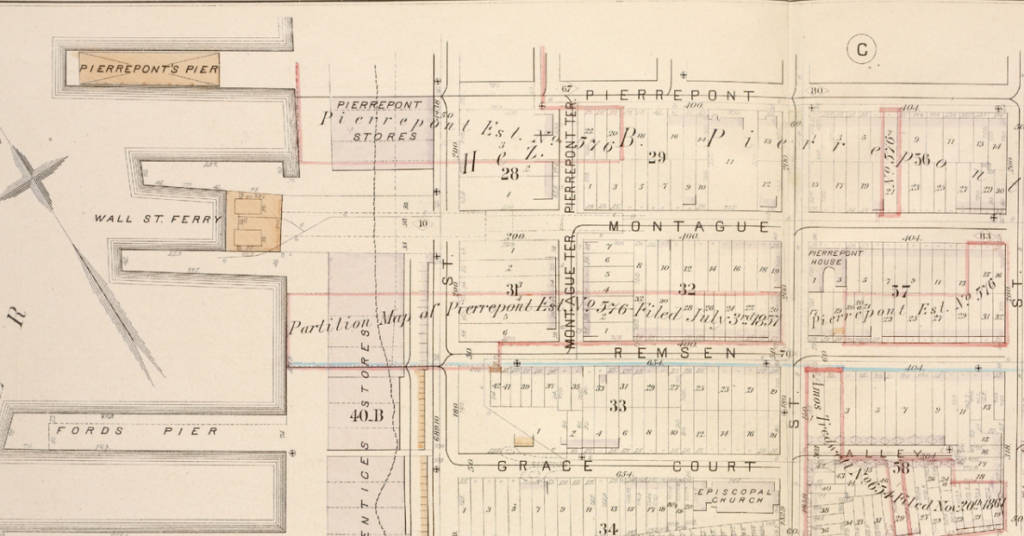
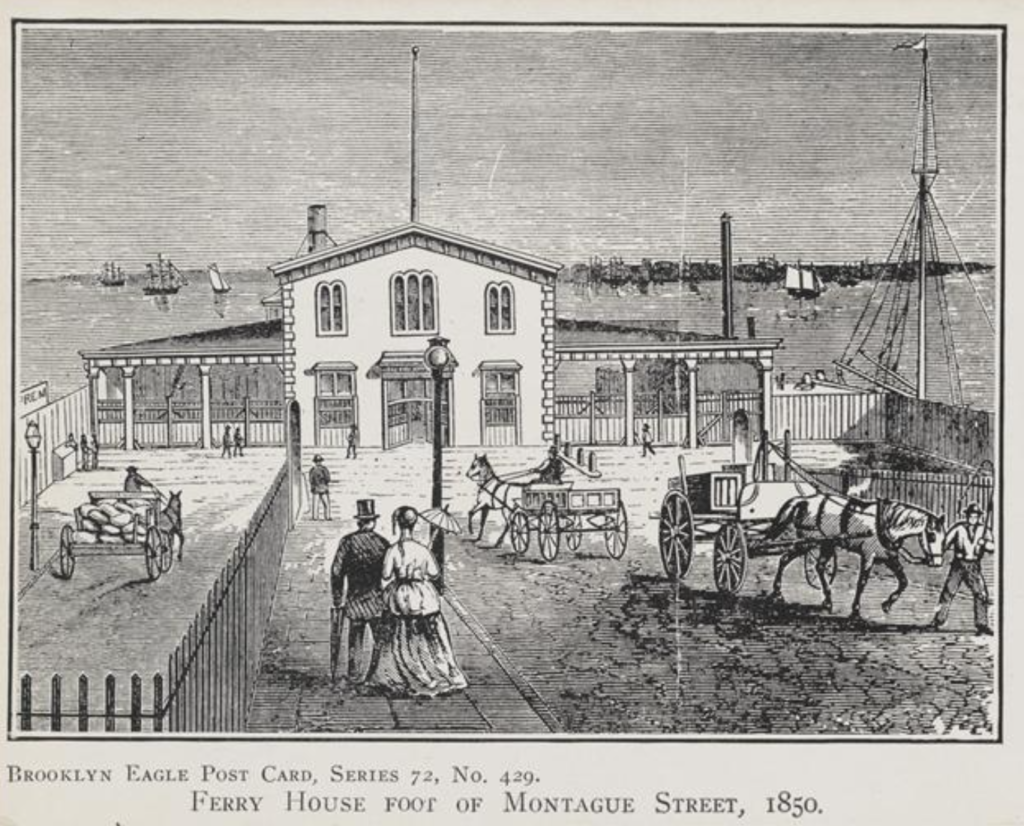
In 1857, two of Hezekiah’s sons, Henry Evelyn and William Constable, established the Pierrepont Stores on what was then called Furman Street, a narrow, cavernous street that ran along the waterfront.
The Pierrepont Stores was described as “a United States bonded warehouse where ships’ freight was received and stored for the owners, insured by the government, until duties were paid.” The warehouse, like those of other prominent Heights’ families, was a major port of entry for products such as sugar and molasses from the Caribbean, Manilla, and other regions.
Around 1895, the Pierreponts and other families merged their stores (warehouses) into a trust called the Brooklyn Wharf and Warehouse Company. Several other commercial Brooklyn dock and warehouse companies, including the Atlantic Dock Company, also merged into the new company. The founders reportedly believed that one entity controlling all the shipping piers in Brooklyn was a sure bet.
It was a bet they would all lose.

The primary business of the Brooklyn Wharf and Warehouse Company was handling grain shipments. Soon after the company formed, however, the trade in grain began to decline. This decline, combined with lower rail rates, brought about the demise of the company.
The New York Dock Company was organized and acquired all the holdings. Pier 12 was constructed in 1906-07 at a cost of $102,289.
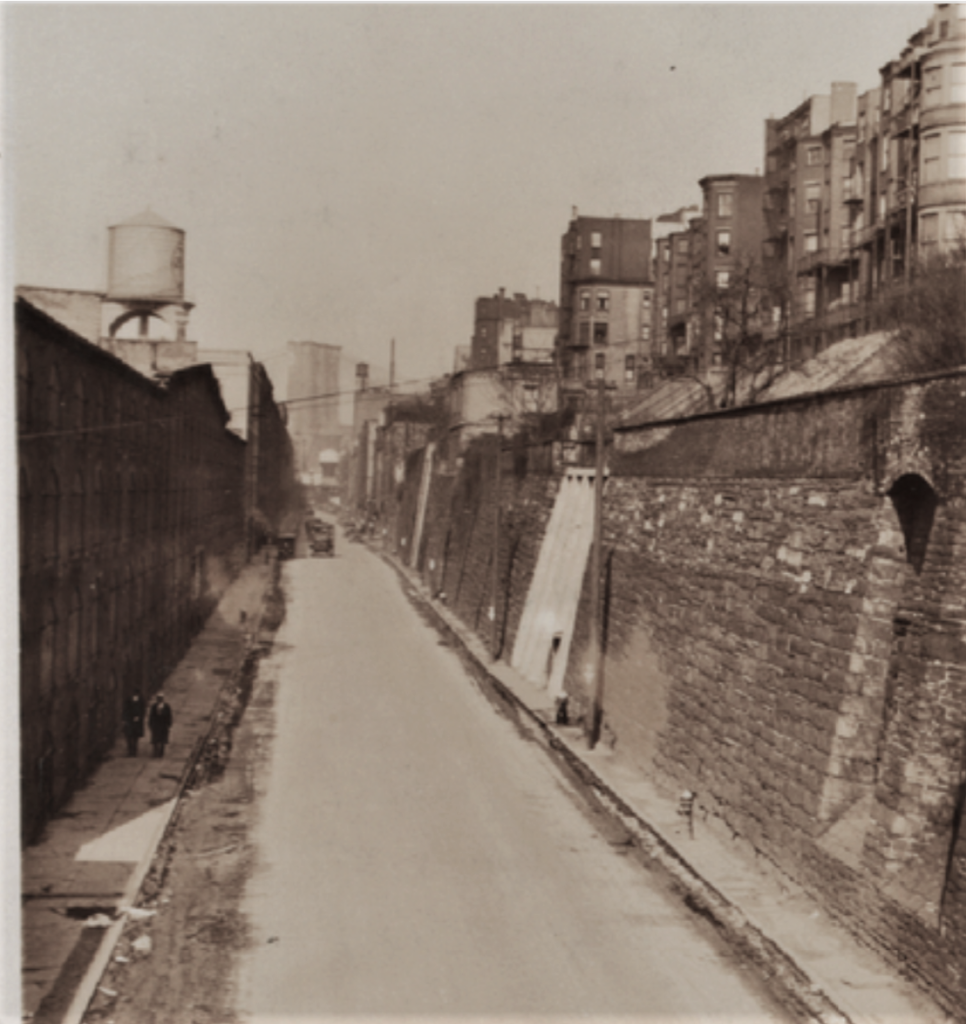
Sometime around 1956, the Port Authority of New York and New Jersey purchased two miles of Brooklyn waterfront from the New York Dock Company. This put in place an $85 million, seven-year development program–the greatest program of its kind ever undertaken in the New York-New Jersey Harbor–comprising the construction of 10 new piers, the rehabilitation of an existing pier, the construction of 3 new warehouses, and the improvement of 50 acres of upland area.
Under the Brooklyn-Port Authority marine terminal development plan, 25 of the existing obsolete piers, which were then up to 65 years old, were replaced with 10 wide, single-story, steel and concrete structures. The plan also replaced 44 narrow, deteriorated berths with 25 modern vessel berths.
In 1984, the Port Authority announced plans to sell the piers for commercial development. This announcement kickstarted interest and a reevaluation of the land’s value as a public resource. In 1998, after more than 10 years of grassroots movements, the Downtown Brooklyn Waterfront Local Development Corporation was created to lead a public planning process for what is now Brooklyn Bridge Park.
Today, the old Pier 12, where Brownie and Flora once reigned as the waterfront’s greatest mousers, is now the site of Pier 3 of the Brooklyn Bridge Park. The pier opened as a park in 2018.
The Cat That Inspired the Brooklyn Heights Promenade
In one of my next posts, I will go into more detail about the Pierrepont family and farm, their Four Chimneys mansion (where George Washington established a signal tower), and a cat (or two) that inspired residents to push for the creation of the Brooklyn Heights Promenade. (Many human engineers liked to take credit for the promenade, but it was in fact a cat that got the ball rolling, so to speak.)
